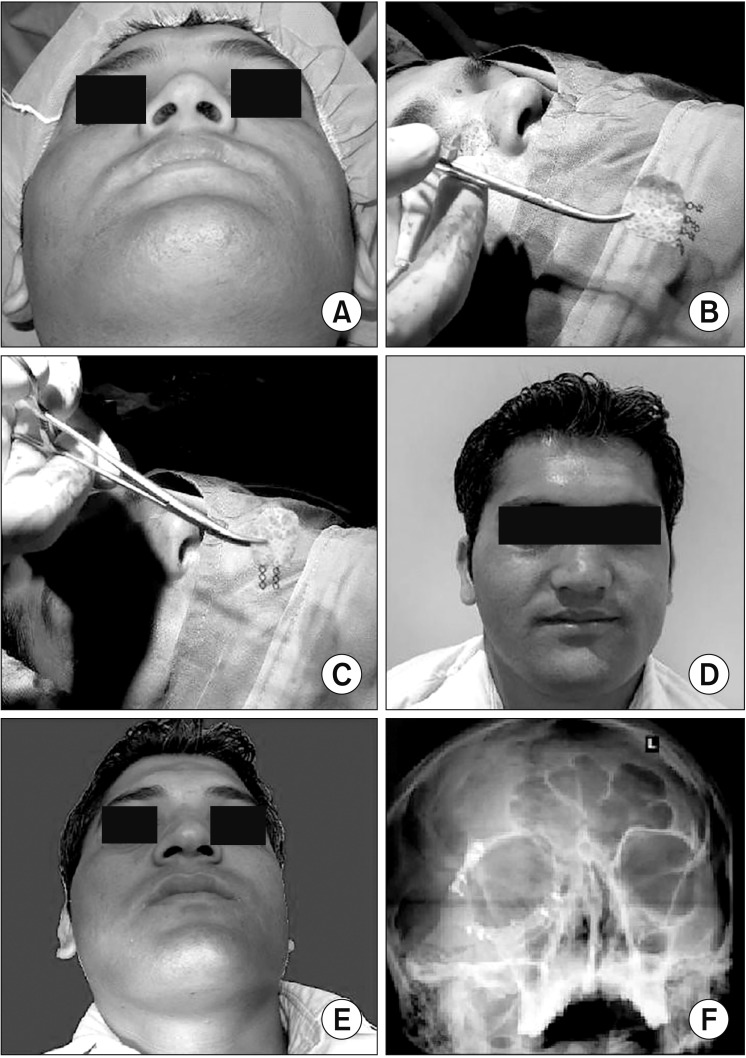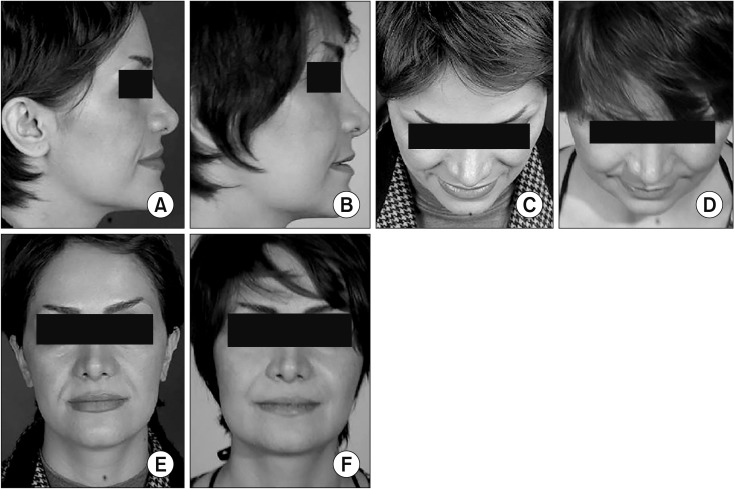J Korean Assoc Oral Maxillofac Surg.
2018 Jun;44(3):128-135. 10.5125/jkaoms.2018.44.3.128.
Maxillofacial reconstruction with Medpor porous polyethylene implant: a case series study
- Affiliations
-
- 1Department of Oral and Maxillofacial Surgery, Faculty of Dentistry, Qazvin University of Medical Sciences, Qazvin, Iran. pejmanjanbaz@yahoo.com
- KMID: 2414432
- DOI: http://doi.org/10.5125/jkaoms.2018.44.3.128
Abstract
OBJECTIVES
The role of alloplastic materials in maxillofacial reconstruction is still controversial. Determining the utility of porous, high-density, polyethylene implants as a highly stable and flexible, porous alloplast, with properties such as rapid vascularization and tissue ingrowth, is crucial in cases of maxillofacial deformities and aesthetic surgery.
MATERIALS AND METHODS
Thirty high-density porous polyethylene implants were implanted in 16 patients that had been referred to a private office over a three-year period. These implants were used for correcting congenital deformities, posttraumatic defects and improving the aesthetic in nasal, paranasal, malar, chin, mandibular angle, body and orbital areas.
RESULTS
The outcomes of the cases in this study showed good aesthetic and functional results. The majority of patients had no signs of discomfort, rejection or exposure. Two implants suffered complications: a complicated malar implant was managed by antibiotic therapy, and an infected mandibular angle implant was removed despite antibiotic therapy.
CONCLUSION
Based on the results, the Medpor implant seems to be an excellent biomaterial for correcting various facial deformities. Advantages include its versatility and relatively ideal pore size that allows for excellent soft tissue ingrowth and coverage. It is strong, flexible and easy to shape.
MeSH Terms
Figure
Cited by 1 articles
-
Classification of the journal category “oral surgery” in the Scopus and the Science Citation Index Expanded: flaws and suggestions
Seong-Gon Kim
J Korean Assoc Oral Maxillofac Surg. 2019;45(4):186-191. doi: 10.5125/jkaoms.2019.45.4.186.
Reference
-
1. Rees TD. Physical considerations for the aesthetic surgery of the neck and face. In : Rees TD, editor. Aesthetic plastic surgery. Philadelphia: W.B. Saunders;1980. p. 587.2. Maas CS, Merwin GE, Wilson J, Frey MD, Maves MD. Comparison of biomaterials for facial bone augmentation. Arch Otolaryngol Head Neck Surg. 1990; 116:551–556. PMID: 2158331.
Article3. Wolfe SA, Berkowitz S. Plastic surgery of the facial skeleton. Boston: Little, Brown;1989. p. 687.4. Spector M, Harmon SL, Kreutner A. Characteristics of tissue growth into proplast and porous polyethylene implants in bone. J Biomed Mater Res. 1979; 13:677–692. PMID: 479215.
Article5. Breadon GE, Kern EB, Neel HB 3rd. Autografts of uncrushed and crushed bone and cartilage. Experimental observations and clinical implications. Arch Otolaryngol. 1979; 105:75–80. PMID: 367338.
Article6. Gosain AK. Plastic Surgery Eductional Foundation DATA Committee. Biomaterials for reconstruction of the cranial vault. Plast Reconstr Surg. 2005; 116:663–666. PMID: 16079708.
Article7. Wellisz T, Lawrence M, Jazayeri MA, Golshani S, Zhou ZY. The effects of alloplastic implant onlays on bone in the rabbit mandible. Plast Reconstr Surg. 1995; 96:957–963. PMID: 7652071.
Article8. Gui L, Huang L, Zhang Z. Genioplasty and chin augmentation with Medpore implants: a report of 650 cases. Aesthetic Plast Surg. 2008; 32:220–226. PMID: 18158607.
Article9. Rubin JP, Yaremchuk MJ. Complications and toxicities of implantable biomaterials used in facial reconstructive and aesthetic surgery: a comprehensive review of the literature. Plast Reconstr Surg. 1997; 100:1336–1353. PMID: 9326803.
Article10. Yaremchuk MJ. Infraorbital rim augmentation. Plast Reconstr Surg. 2001; 107:1585–1592. PMID: 11335841.
Article11. Shanbhag A, Friedman HI, Augustine J, von Recum AF. Evaluation of porous polyethylene for external ear reconstruction. Ann Plast Surg. 1990; 24:32–39. PMID: 2301880.
Article12. Frodel JL, Lee S. The use of high-density polyethylene implants in facial deformities. Arch Otolaryngol Head Neck Surg. 1998; 124:1219–1223. PMID: 9821923.
Article13. Wellisz T, Dougherty W. The role of alloplastic skeletal modification in the reconstruction of facial burns. Ann Plast Surg. 1993; 30:531–536. PMID: 8368781.14. Romano JJ, Iliff NT, Manson PN. Use of Medpor porous polyethylene implants in 140 patients with facial fractures. J Craniofac Surg. 1993; 4:142–147. PMID: 8241356.
Article15. Nélaton C, Ombrédanne L, Berger P, Hartmann H. La rhinoplastie. Paris: G. Steinheil;1904.16. Joseph J. Treatise on rhinoplasty. Berl Klin Wochenschr. 1907; 44:470.17. Israel J. Two new methods of rhinoplasty. Plast Reconstr Surg. 1970; 46:80–83. PMID: 4914406.
Article18. Von Mangold H. Correction of saddle nose by cartilage transplant. Gesell Chir. 1900; 29:460–463.19. Brown JB, Fryer MP, Randall P, Lu M. Silicones in plastic surgery; laboratory and clinical investigations, a preliminary report. Plast Reconstr Surg (1946). 1953; 12:374–376. PMID: 13111916.20. Niazi TN, Coppens J, Liu JK, Couldwell WT. Medpor implant in cranioorbitomaxillary reconstruction: institutional experience and a review of the literature. J Oral Maxillofacial Surg. 2008; 7:444–448.21. Deshpande S, Munoli A. Long-term results of high-density porous polyethylene implants in facial skeletal augmentation: an Indian perspective. Indian J Plast Surg. 2010; 43:34–39. PMID: 20924447.
Article22. Ram H, Singh RK, Mohammad S, Gupta AK. Efficacy of Iliac crest vs. Medpor in orbital floor reconstruction. J Maxillofac Oral Surg. 2010; 9:134–141. PMID: 22190772.
Article23. Cenzi R, Guarda-Nardini L. [Use of porous plyethylene (Medpor) in maxillofacial surgery]. Minerva Stomatol. 1995; 44:559–582. Italian. PMID: 8725075.24. Rubin PA, Bilyk JR, Shore JW. Orbital reconstruction using porous polyethylene sheets. Ophthalmology. 1994; 101:1697–1708. PMID: 7936569.
Article25. Klawitter JJ, Bagwell JG, Weinstein AM, Sauer BW. An evaluation of bone growth into porous high density polyethylene. J Biomed Mater Res. 1976; 10:311–323. PMID: 1254618.
Article26. Spector M, Flemming WR, Sauer BW. Early tissue infiltrate in porous polyethylene implants into bone: a scanning electron microscope study. J Biomed Mater Res. 1975; 9:537–542. PMID: 1176523.
Article27. Kim HS, Park SS, Kim MH, Kim MS, Kim SK, Lee KC. Problems associated with alloplastic materials in rhinoplasty. Yonsei Med J. 2014; 55:1617–1623. PMID: 25323900.
Article28. Ridwan-Pramana A, Wolff J, Raziei A, Ashton-James CE, Forouzanfar T. Porous polyethylene implants in facial reconstruction: outcome and complications. J Craniomaxillofac Surg. 2015; 43:1330–1334. PMID: 26276064.
Article29. Niechajev I. Facial reconstruction using porous high-density polyethylene (Medpor): long-term results. Aesthetic Plast Surg. 2012; 36:917–927. PMID: 22684610.
Article30. Mohammadi S, Mohseni M, Eslami M, Arabzadeh H, Eslami M. Use of porous high-density polyethylene grafts in open rhinoplasty: no infectious complication seen in spreader and dorsal grafts. Head Face Med. 2014; 10:52. PMID: 25534471.
Article31. Baj A, Spotti S, Marelli S, Beltramini GA, Giannì AB. Use of porous polyethylene for correcting defects of temporal region following transposition of temporalis myofascial flap. Acta Otorhinolaryngol Ital. 2009; 29:265–269. PMID: 20162028.32. Rapidis AD, Day TA. The use of temporal polyethylene implant after temporalis myofascial flap transposition: clinical and radiographic results from its use in 21 patients. J Oral Maxillofac Surg. 2006; 64:12–22. PMID: 16360852.
Article33. Xu JJ, Teng L, Jin XL, Ji Y, Lu JJ, Zhang B. Porous polyethylene implants in orbital blow-out fractures and enophthalmos reconstruction. J Craniofac Surg. 2009; 20:918–920. PMID: 19480046.34. Tsouknidas A, Maropoulos S, Savvakis S, Michailidis N. FEM assisted evaluation of PMMA and Ti6Al4V as materials for cranioplasty resulting mechanical behaviour and the neurocranial protection. Biomed Mater Eng. 2011; 21:139–147. PMID: 22072078.
Article35. Sun L, Xiao J, Lan Y, Xiong Y, Zhang L, Zhou H, et al. [Reconstruction of the orbital fracture with enophthalmos using customized titanium mesh combined with Medpor]. Hua Xi Kou Qiang Yi Xue Za Zhi. 2015; 33:272–275. Chinese. PMID: 26281256.36. He D, Li Z, Shi W, Sun Y, Zhu H, Lin M, et al. Orbitozygomatic fractures with enophthalmos: analysis of 64 cases treated late. J Oral Maxillofac Surg. 2012; 70:562–576. PMID: 21752509.
Article37. Yilmaz M, Vayvada H, Aydin E, Menderes A, Atabey A. Repair of fractures of the orbital floor with porous polyethylene implants. Br J Oral Maxillofac Surg. 2007; 45:640–644. PMID: 17681408.
Article38. Lin IC, Liao SL, Lin LL. Porous polyethylene implants in orbital floor reconstruction. J Formos Med Assoc. 2007; 106:51–57. PMID: 17282971.
Article39. Cenzi R, Farina A, Zuccarino L, Carinci F. Clinical outcome of 285 Medpor grafts used for craniofacial reconstruction. J Craniofac Surg. 2005; 16:526–530. PMID: 16077294.
Article40. Yaremchuk MJ. Facial skeletal reconstruction using porous polyethylene implants. Plast Reconstr Surg. 2003; 111:1818–1827. PMID: 12711941.
Article41. Gosau M, Schiel S, Draenert GF, Ihrler S, Mast G, Ehrenfeld M. [Craniofacial augmentation with porous polyethylene implants (Medpor): first clinical results]. Mund Kiefer Gesichtschir. 2006; 10:178–184. German. PMID: 16685567.42. Menderes A, Baytekin C, Topcu A, Yilmaz M, Barutcu A. Craniofacial reconstruction with high-density porous polyethylene implants. J Craniofac Surg. 2004; 15:719–724. PMID: 15346006.
Article43. Romo T 3rd, Litner JA, Sclafani AP. Management of the severe bulbous nasal tip using porous polyethylene alloimplants. Facial Plast Surg. 2003; 19:341–348. PMID: 14737703.
Article44. Emsen IM. E-M shaped septal encircling with Medpor reconstruction on crooked noses: personal technique and postoperative results. J Craniofac Surg. 2008; 19:216–226. PMID: 18216692.
- Full Text Links
- Actions
-
Cited
- CITED
-
- Close
- Share
- Similar articles
-
- THE USE OF MEDPOR(TM) (POROUS HIGH-DENSITY POLYETHYLENE) IN ORAL AND MAXILLOFACIAL REGION
- A Case of Medpor(R) Orbital Implant Infection
- The Correction of the Mandibular Defect Using Porous Polyethylene: Case Report
- Clinical Effect of Porous Polyethylene (Medpor(r))Orbital Implant
- Cranioplasty with the Porous Polyethylene Implant(Medpor) for Large Cranial Defect





